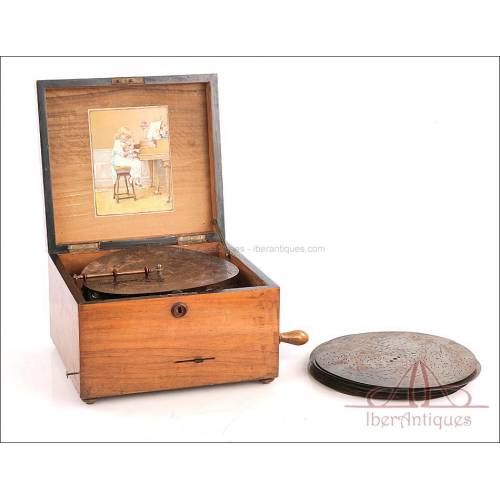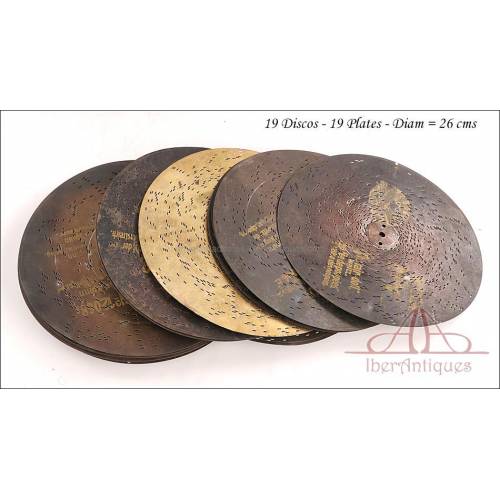Antique Music Boxes
There are few devices that generate as much attraction as old music boxes. Who has not had in his childhood a little string box, that when lifting the lid let out a melody that was constantly repeated... Or perhaps, a small mechanism with a crank that played a popular tune. Antique music boxes take us directly to that "age of mechanical ingenuit...
There are few devices that generate as much attraction as old music boxes. Who has not had in his childhood a little string box, that when lifting the lid let out a melody that was constantly repeated... Or perhaps, a small mechanism with a crank that played a popular tune. Antique music boxes take us directly to that "age of mechanical ingenuity" that began in the 19th century and extended into the first decades of the 20th century. Clocks, phonographs, gramophones, pianolas... Wonderful and nostalgic inventions, which are the first step towards the technology we enjoy today. Our antique music boxes cover several decades, from 1800 to 1920: they are high quality models, which still surprise us today for their smooth operation and variety of melodies.
History of antique music boxes.
Music boxes have undergone constant evolution over the centuries. The earliest recorded designs date back to the 9th century, when the Musa brothers of Baghdad built a device called an "automatophone", capable of reproducing sounds by means of a spiked cylinder. Great scientists and inventors such as Athanasius Kirchner and Leonardo da Vinci also experimented with the construction of musical devices, which usually included automatons. However, the first patented music box as such is attributed to Antoine Favre, who built it in 1796, replacing the typical bells with a steel plate comb. Years later, in 1865, the Swiss Charles Reuge founded a watchmaking company that his son Albert would later expand into the construction of music boxes. The Reuge firm became a world leader in the manufacture of these items.
In 1889 Paul Lochman manufactured the first music box with a disc system, more convenient to store and lighter than cylinders. At the same time the barrel organs were being developed, old music boxes that worked by a pneumatic system and rolls or punched paper cards. The evolution of the music boxes and barrel organs were the mechanical pianos or pianolas, which eventually replaced them both. All these devices became obsolete inventions with the advent of the radio, the phonograph and the gramophone; however, the fascination they arouse is still alive, and today fans of collecting antique music boxes are counted by the thousands.
Types of antique music boxes
Antique cylinder music boxes
They work with a cylinder of spikes, strategically distributed over their entire surface. When they come into contact over a comb of vibrating metal blades, they generate notes that combine to create melodies. The simplest models operate by cranking a hand crank, but the most complex and beautiful ones have a clockwork mechanism that is driven by a winding motor.
Antique disc music boxes
Their operation is similar to the cylinder ones, but in this case the cylinder is replaced by a rotating disc (whose mechanism is a precursor of gramophones) equipped with small tabs on its lower side. The tabs drive the moving pins of a cylinder, which in turn generate the melody.
Antique music boxes with pneumatic system.
The pneumatic system is similar to the one that runs organs. Operated by a crank, the cylinder that integrates the mechanism of these music boxes opens and closes a series of keys. The keys interrupt or facilitate the passage of air, which previously passes through pipes or reeds and makes them sound. The barrel organs are actually old-fashioned pneumatically operated music boxes, with the tunes recorded on paper rolls or punched cards.
Antique music boxes are still objects full of beauty and charm, perfect for decorating and for completing attractive collections. Their delicate sound is still as vivid as when they were the most popular musical devices of their time.
Antique Adler Mahogany Disc Music Box, Germany, 1900 Antique Adler Mahogany Disc...
Antique Adler mahogany music box, crafted in Germany circa 1900. Designed for interchangeable 21 cm discs. Antique Adler mahogany music box,...
430,00 €Antique Troubadour Mahogany Music Box with 9 Discs, Germany circa 1900 Antique Troubadour Mahogany...
German Troubadour music box, c.1900, made of mahogany. Includes 9 original 22.5 cm discs and a complete working comb. German Troubadour music box, c.1900,...
SoldAntique Adler Music Box with 19 Interchangeable Discs, Germany, 1900 Antique Adler Music Box with 19...
Antique Adler music box with interchangeable discs. Includes 19 discs (26 cm), full comb mechanism, and functional movement. Antique Adler music box with...
SoldAntique Polyphon Music Box with 15 Disks. Switzerland, 19th Century Antique Polyphon Music Box with...
Gorgeous Polyphon music box in excellent condition. Perfect working order. Complete and with 15 metal disks. Gorgeous Polyphon music box in...
Sold
New products
-

Antique ivory and silver plated stethoscope, late 19th century
Antique stethoscope from the late 19th century in silver-plated metal...
-

Vintage pendant with shell cameo of Jesús del Gran Poder, carved c. 1970
Vintage pendant with a shell-carved cameo of Jesus del Gran Poder, circa...
-

Antique Roman Style Gilded Silver Chalice with Paten. France, 1932
Antique Roman-style chalice in gilded silver with paten. France, 1932....
-

Beautiful Antique 18 K Gold Ring with 7 Natural Diamonds
Antique 18K gold ring with 7 natural diamonds. Delicate openwork design,...
-

Antique Silver Reliquary. José Vilaplana. Valencia, Spain. Circa 1920
Impressive repoussé silver reliquary by José Vilaplana, Valencia, c....
-

Vintage 18K Gold Ring with 7 Natural Diamonds
Vintage 18K gold ring with seven natural diamonds in floral setting....
-

Antique Silver Chalice. Enameled Crosses. Valencia, Spain, 1942
Spanish chalice from 1942 in solid silver, gifted by the Church of...
-

Antique Silver Chalice and Paten. Granada Spain, circa 1900
Spanish chalice in white silver with matching paten, handcrafted....
Specials
-

Antique Gilt Silver Chalice with Iconography of Saints and Paten, c. 1900
Spanish gilt silver chalice (900...









